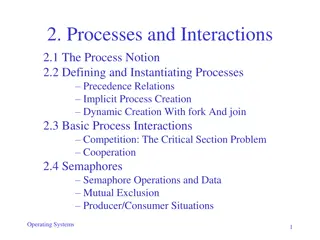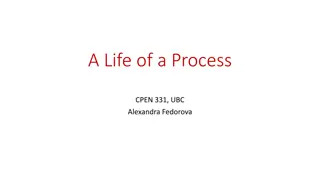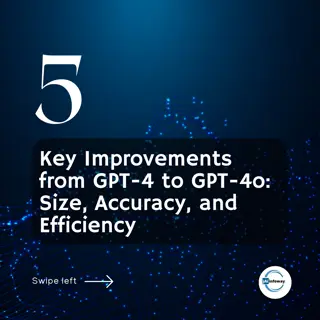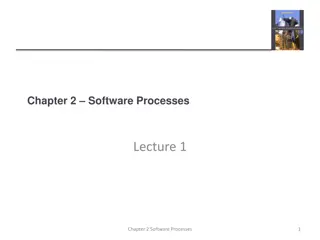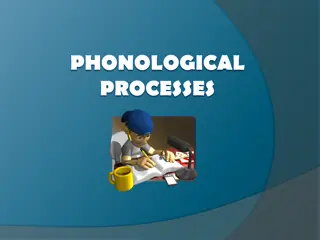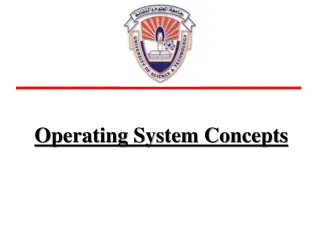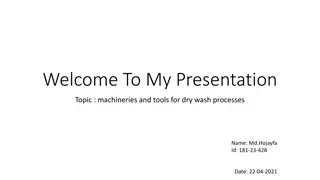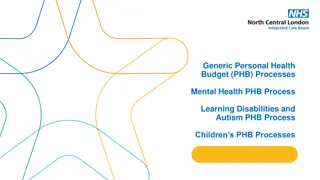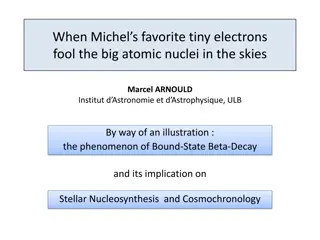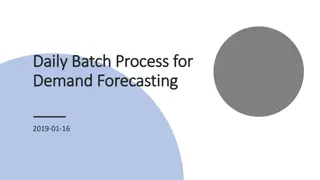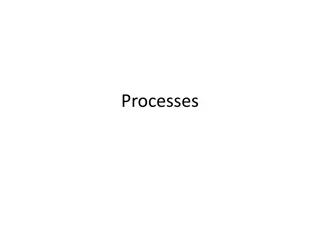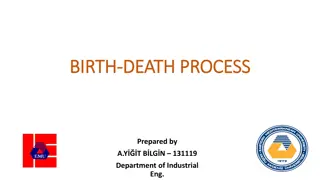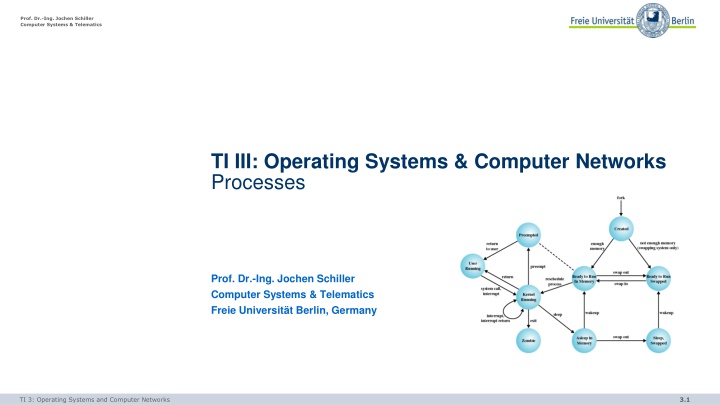
Operating Systems and Computer Networks: Processes and Concepts
Dive into the fundamentals of operating systems and computer networks through topics like processes, memory, scheduling, I/O, security, and more. Explore the definitions, distinctions, and tasks associated with processes and learn about related concepts like threads and applications. Discover the crucial role of the operating system in managing processes efficiently and supporting inter-process communication.
Download Presentation

Please find below an Image/Link to download the presentation.
The content on the website is provided AS IS for your information and personal use only. It may not be sold, licensed, or shared on other websites without obtaining consent from the author. If you encounter any issues during the download, it is possible that the publisher has removed the file from their server.
You are allowed to download the files provided on this website for personal or commercial use, subject to the condition that they are used lawfully. All files are the property of their respective owners.
The content on the website is provided AS IS for your information and personal use only. It may not be sold, licensed, or shared on other websites without obtaining consent from the author.
E N D
Presentation Transcript
Prof. Dr.-Ing. Jochen Schiller Computer Systems & Telematics TI III: Operating Systems & Computer Networks Processes Prof. Dr.-Ing. Jochen Schiller Computer Systems & Telematics Freie Universit t Berlin, Germany TI 3: Operating Systems and Computer Networks 3.1
Content 1. Introduction and Motivation 2. Subsystems, Interrupts and System Calls 3. Processes 4. Memory 5. Scheduling 6. I/O and File System 7. Booting, Services, and Security TI 3: Operating Systems and Computer Networks 3.2
Definitions of a Process Program in execution Instance of a program running on a computer -There may be multiple instances of the same program, each as a separate process Unit characterized by -Execution of a sequence of instructions -Current state -Associated block of memory TI 3: Operating Systems and Computer Networks 3.3
Related Concepts to Process Thread: One (of several) runtime entities that share the same address space -Easy cooperation, requires explicit synchronization -A process may consist of several threads Application: User-visible entity, one or more processes TI 3: Operating Systems and Computer Networks 3.4
Program vs. Process Multiple parts -Program code text section -Current activity program counter, processor registers -Stack temporary data -Data section global variables -Heap dynamic memory Program is passive entity, process is active -Program becomes process when executable file loaded into memory One program can be several processes TI 3: Operating Systems and Computer Networks 3.5
Tasks of an OS concerning processes Interleaved execution (by scheduling) of multiple processes -Maximization of processor utilization -Reduction of response time Allocation of resources for processes -Consideration of priorities -Avoidance of deadlocks Support for Inter-Process Communication (IPC) On-demand user-level process creation -Structuring of applications TI 3: Operating Systems and Computer Networks 3.6
Process execution (Trace) TI 3: Operating Systems and Computer Networks 3.7
Process execution (Trace) TI 3: Operating Systems and Computer Networks 3.8
Questions & Tasks -Check the number and type of processes and threads running on your computer surprised? -What are many of the invisible processes used for? Who started them? -Why can several instances of the same program running as individual processes make sense? -What could be disadvantages? -Who is responsible for the interleaved execution of multiple processes? -But how can this be done if we assume a single processor running a single process that does not want to leave this processor? -Name some criteria for schedulers! TI III - Operating Systems and Computer Networks 3.9
Simple Process Model Process is in one of two states: -running -not running How to implement? TI 3: Operating Systems and Computer Networks 3.10
Simple Process Model Running processes managed in queue: What information required? TI 3: Operating Systems and Computer Networks 3.11
Process Control Block (PCB) Definition: OS data structure which contains the information needed to manage a process (one PCB per process) IDs of process, parent process, and user Process identifiers User-visible registers Control and status registers: Stack pointer (SP) Program counter (PC) Processor status word (PSW) CPU state Scheduling information: Process state, priority, awaited event Accounting information: Amount of memory used, CPU time elapsed Memory management: Location and access state of all user data I/O management: Devices currently opened (files, sockets) Control information TI 3: Operating Systems and Computer Networks 3.12
Process Control Block (PCB) TI 3: Operating Systems and Computer Networks 3.13
Reasons for Process Creation Interactive logon -User logs onto a terminal -May create several processes as part of logon procedure (e.g. GUI) Created by the OS to provide a service -Provide a service to user program in the background (e.g. printer spooling) -Either at boot time or dynamically in response to requests (e.g. HTTP) Spawned at application start-up -Separation of a program into separate processes for algorithmic purposes Always spawned by existing process -Operating system creates first process at boot time -Processes are organized in a tree-like structure (`pstree`) TI 3: Operating Systems and Computer Networks 3.14
Process Termination Execution of process is completed -process terminates itself by system call Other user process terminates the process -Parent process or other authorized processes OS terminates process for protection reasons -Invalid instruction (process tries to execute data) -Privileged instruction in user mode -Process tries to access memory without permission -I/O-Error -Arithmetic error Some exceptions can be caught and handled by the process. TI 3: Operating Systems and Computer Networks 3.15
Questions & Tasks -What are disadvantages of the simple FIFO-queue in our simple process model? -What could be alternatives? -Start your favorite process monitor, then start programs, use them, terminate them and monitor the list of current processes and threads to get a better understanding of your system! -How can you kill a process that goes crazy? -Can you (as a normal user) kill all processes? Try it and see what happens! PLEASE: Do not do this while running anything important, save all files before you do this -What is the role of a administrator/root/superuser in this context? TI III - Operating Systems and Computer Networks 3.16
Process Model Simple model with two states Problems -Most of the processes will be waiting for IO -Different IO devices -Different priorities Extend the model TI 3: Operating Systems and Computer Networks 3.17
Extended Process Model Five states including creation, termination, and resource handling: Running: currently being executed Ready: ready to run, waiting for execution Blocked: not ready to run, waiting for external event, e.g., completion of I/O operation New: newly created process, not yet in running set Exit: completed/terminated process, removed from running set TI 3: Operating Systems and Computer Networks 3.18
Process States over Time TI 3: Operating Systems and Computer Networks 3.19
Implementation of Process States Assign process to different queues based on state of required resources Two queues: -Ready processes (all resources available) -Blocked processes (at least one resource busy) But what happens if processes need different resources? TI 3: Operating Systems and Computer Networks 3.20
Improved Implementation Several queues one for each resource / type of resource Release Ready Queue Admit Dispatch Processor Timeout Event 1 Queue Event 1 Wait Event 1 Occurs Event 2 Queue Event 2 Wait Event 2 Occurs More efficient, but fairness issues must be considered Event n Queue Event nWait Event n Occurs (b) Multiple blocked queues TI 3: Operating Systems and Computer Networks 3.21
Suspension / Swapping of Processes Swapping motivated by two observations: -Physical main memory is (was) a scarce resource -Blocked processes may wait for longer periods of time (e.g. during I/O, while waiting for requests, ...) Swap blocked processes to secondary storage thereby reducing memory usage TI 3: Operating Systems and Computer Networks 3.22
Extended Process State Diagram Two additional considerations -Blocked/swapped processes may become ready to run when event occurs -Ready and/or running processes may be swapped even without waiting for event TI 3: Operating Systems and Computer Networks 3.23
Questions & Tasks -What is a typical state for a typical program you use, such as e.g. text processing, email, chat etc.? -So what is your computer normally doing (unless you are an active gamer )? -How do interrupts fit into the picture of processes, queues, scheduling? -How and where to implement different priorities? -What does swapping involve? Think of the memory hierarchy! -Can you notice swapping? -Can we swap all processes? TI III - Operating Systems and Computer Networks 3.24
Processes and Resource Allocation Process state reflects allocated resources: Running Blocked Ready/Suspended Required resource available Required resource not available TI 3: Operating Systems and Computer Networks 3.25
Global data structures for processes and resources usage Process tables: -Process Control Block (PCB) -Location of process image in memory -Resources (process-specific view) I/O tables: -Allocation of I/O devices, assignment to processes -State of current operation and corresponding memory region File tables: -Currently open files -Location on storage media / secondary memory -State and attributes Memory tables: -Allocation of primary and secondary memory -Protection attributes of blocks of (shared) memory -Virtual memory management TI 3: Operating Systems and Computer Networks 3.26
Process Control Table and Image Process Image Memory Tables Process 1 Memory I/O Tables Devices Files Processes File Tables Primary Process Table Process 1 Process 2 Process Image Process 3 Process n Process n TI 3: Operating Systems and Computer Networks 3.27
Kernel / Process Implementations Separated kernel and processes: -Separate memory and stack for kernel -Kernel is no process Expensive and unsafe P1 P2 Pn Kernel (a) Separate kernel TI 3: Operating Systems and Computer Networks 3.28
Kernel / Process Implementations Execution of system calls as part of user process, but in kernel mode: -Kernel functions use same address space -Same process switches into privileged mode (Ring 0) Less expensive and quite safe P1 P2 Pn OS Func- tions OS Func- tions OS Func- tions Process Switching Functions (b) OS functions execute within user processes TI 3: Operating Systems and Computer Networks 3.29
Kernel / Process Implementations Microkernel: -Collection of system processes that provide OS services Quite expensive but very safe P1 P2 Pn OS1 OSk Process Switching Functions (c) OS functions execute as separate processes TI 3: Operating Systems and Computer Networks 3.30
Questions & Tasks -Make sure you understand how to implement tables, references to tables, pointers etc.! -What is expensive when it comes to certain kernel/process implementations? -What can be unsafe ? -Read e.g. https://www.oreilly.com/library/view/understanding-the-linux/0596002130/ch01s06.html to get more insight! (Understanding the Linux Kernel, Daniel P. Bovet, Marco Cesati, O Reilly) TI III - Operating Systems and Computer Networks 3.31
Example: UNIX Architecture Process architecture that executes kernel functions in the context of a user process P1 P2 Pn OS Func- tions OS Func- tions OS Func- tions Process Switching Functions Two modes are used: user / kernel mode (Ring 3/Ring 0) Two types of processes: system / user processes System processes are implemented as part of kernel to run background services, e.g. swapping TI 3: Operating Systems and Computer Networks 3.32
Example: UNIX Process State Diagram TI 3: Operating Systems and Computer Networks 3.33
Example: UNIX Process States TI 3: Operating Systems and Computer Networks 3.34
Related System Calls int execve(const char *filename, char *const argv[], char *const envp[]) -Executes program pointed to by filename with arguments argv and environment envp (in the form of key=value) -Effectively replaces the current program with another one exec() family of library function pid_t fork(void) -Creates child process that differs from parent only in its PID (process identifier) and PPID (parent process identifier) -Returns 0 for child process and child s PID for parent process void _exit(int status) -Terminates calling process; closes open file descriptors; children are adopted by process 1; signals termination to parent exit() library function pid_t wait(int *status) -Wait for state change in child of calling process TI 3: Operating Systems and Computer Networks 3.35
Programming Example #include <stdio.h> #include <stdlib.h> #include <sys/wait.h> main() { int status; pid_t pid; pid = fork(); if(pid == 0) { printf("Child process running...\n"); // Do something... printf("Child process done.\n"); exit(123); } else if(pid > 0) { printf("Parent process, waiting for child %d...\n", pid); pid = wait(&status); printf("Child process %d terminated, status %d.\n", pid, WEXITSTATUS(status)); exit(EXIT_SUCCESS); } else { printf("fork() failed\n"); exit(EXIT_FAILURE); } } TI 3: Operating Systems and Computer Networks 3.36
User-Level Process Control TI 3: Operating Systems and Computer Networks 3.37
User-Level Process Control TI 3: Operating Systems and Computer Networks 3.38
Content 1. Introduction and Motivation 2. Subsystems, Interrupts and System Calls 3. Processes 4. Memory 5. Scheduling 6. I/O and File System 7. Booting, Services, and Security TI 3: Operating Systems and Computer Networks 3.39

